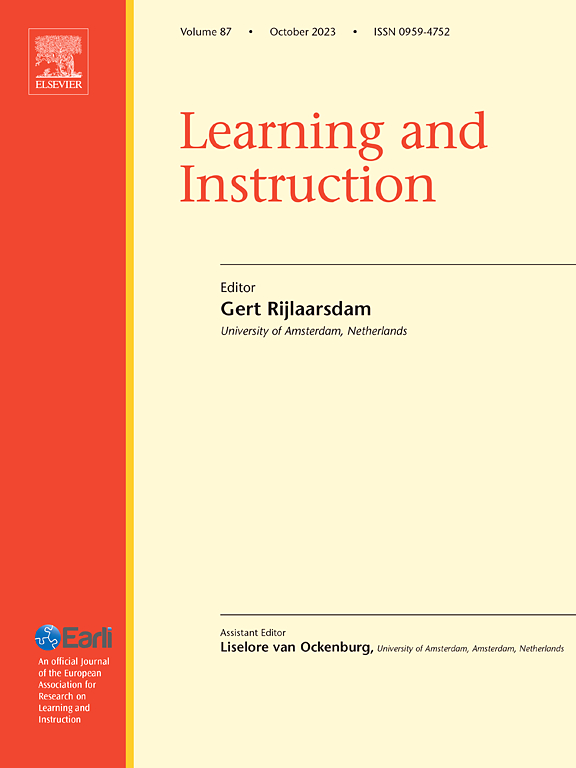Trait resilience against classroom discrimination: Exploring protective effects on immigrant students’ academic achievement across 59 economies
IF 4.9
1区 教育学
Q1 EDUCATION & EDUCATIONAL RESEARCH
引用次数: 0
Abstract
Background
The adaptation of immigrant students is crucial for addressing societal development challenges, including potential demographic shifts. While research has explored various risk, promotive and protective factors impacting these students, there is a need for a deeper understanding of how these factors interact and influence their adaptation.
Aims
This study aimed to examine the protective effect of trait resilience that helps immigrant students against discriminatory school climate and compare the difference with non-immigrant students across 59 economies.
Methods
Using the PISA 2018 database, 375,680 students from 15,147 schools in 59 economies were selected. A two-level multilevel model was utilized to explore the potential moderated effect of trait resilience against discriminatory school climate for both immigrant and non-immigrant students.
Results
A discriminatory school climate contributed to students' negative academic achievement, with the detrimental impact being significantly more pronounced for second-generation immigrant students. Trait resilience, however, played a promotive role in enhancing academic performance for both immigrant and non-immigrant students. Furthermore, trait resilience had a protective effect, mitigating the negative effect of discrimination on students’ academic achievement. Specifically, the protective effect of trait resilience against the negative impact of severe discrimination was stronger for first- and second-generation immigrants than their ethnic majority peers.
Conclusions
Our findings underscore the protective role of trait resilience for immigrant students facing discrimination. It is essential for educational policies and programs to both fight discrimination and foster resilience, particularly for immigrant students, to promote equity and academic success in diverse school environments.
针对课堂歧视的特质弹性:探讨59个经济体移民学生学业成绩的保护效应
移民学生的适应对于解决社会发展挑战至关重要,包括潜在的人口变化。虽然研究已经探索了影响这些学生的各种风险、促进和保护因素,但需要更深入地了解这些因素如何相互作用并影响他们的适应。目的本研究旨在探讨移民学生特质弹性的保护作用,帮助移民学生对抗歧视性的学校环境,并比较59个经济体中移民学生与非移民学生的差异。方法利用PISA 2018数据库,从59个经济体的15147所学校中选出375680名学生。本研究采用两层次多层次模型探讨移民和非移民学生特质弹性对歧视性学校气候的潜在调节作用。结果性别歧视的学校氛围导致学生学业成绩下降,且对移民二代学生的影响更为显著。而特质弹性对移民和非移民学生的学业成绩均有促进作用。此外,特质弹性具有保护作用,减轻了歧视对学生学业成绩的负面影响。具体而言,第一代和第二代移民的特质弹性对严重歧视负面影响的保护作用强于其多数族裔同龄人。结论本研究强调了特质弹性在移民学生面临歧视时的保护作用。教育政策和项目必须打击歧视,培养适应力,特别是移民学生的适应力,从而在多样化的学校环境中促进公平和学业成功。
本文章由计算机程序翻译,如有差异,请以英文原文为准。
求助全文
约1分钟内获得全文
求助全文
来源期刊

Learning and Instruction
Multiple-
CiteScore
11.30
自引率
4.80%
发文量
109
期刊介绍:
As an international, multi-disciplinary, peer-refereed journal, Learning and Instruction provides a platform for the publication of the most advanced scientific research in the areas of learning, development, instruction and teaching. The journal welcomes original empirical investigations. The papers may represent a variety of theoretical perspectives and different methodological approaches. They may refer to any age level, from infants to adults and to a diversity of learning and instructional settings, from laboratory experiments to field studies. The major criteria in the review and the selection process concern the significance of the contribution to the area of learning and instruction, and the rigor of the study.
 求助内容:
求助内容: 应助结果提醒方式:
应助结果提醒方式:


